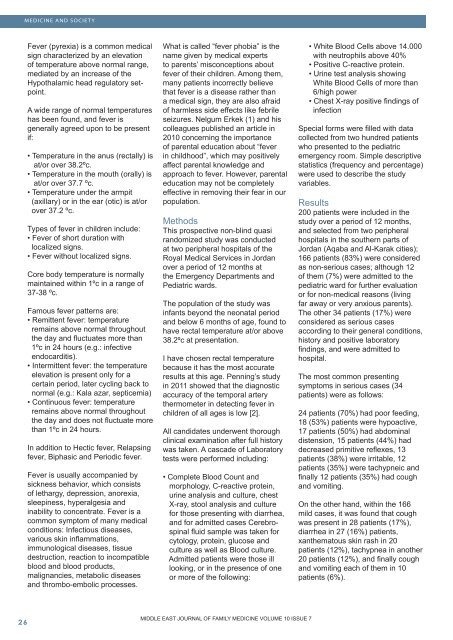full pdf of issue - Middle East Journal of Family Medicine
full pdf of issue - Middle East Journal of Family Medicine
full pdf of issue - Middle East Journal of Family Medicine
- No tags were found...
You also want an ePaper? Increase the reach of your titles
YUMPU automatically turns print PDFs into web optimized ePapers that Google loves.
MEDICINE AND SOCIET YFever (pyrexia) is a common medicalsign characterized by an elevation<strong>of</strong> temperature above normal range,mediated by an increase <strong>of</strong> theHypothalamic head regulatory setpoint.A wide range <strong>of</strong> normal temperatureshas been found, and fever isgenerally agreed upon to be presentif:• Temperature in the anus (rectally) isat/or over 38.2ºc.• Temperature in the mouth (orally) isat/or over 37.7 ºc.• Temperature under the armpit(axillary) or in the ear (otic) is at/orover 37.2 ºc.Types <strong>of</strong> fever in children include:• Fever <strong>of</strong> short duration withlocalized signs.• Fever without localized signs.Core body temperature is normallymaintained within 1ºc in a range <strong>of</strong>37-38 ºc.Famous fever patterns are:• Remittent fever: temperatureremains above normal throughoutthe day and fluctuates more than1ºc in 24 hours (e.g.: infectiveendocarditis).• Intermittent fever: the temperatureelevation is present only for acertain period, later cycling back tonormal (e.g.: Kala azar, septicemia)• Continuous fever: temperatureremains above normal throughoutthe day and does not fluctuate morethan 1ºc in 24 hours.In addition to Hectic fever, Relapsingfever, Biphasic and Periodic fever.Fever is usually accompanied bysickness behavior, which consists<strong>of</strong> lethargy, depression, anorexia,sleepiness, hyperalgesia andinability to concentrate. Fever is acommon symptom <strong>of</strong> many medicalconditions: Infectious diseases,various skin inflammations,immunological diseases, t<strong>issue</strong>destruction, reaction to incompatibleblood and blood products,malignancies, metabolic diseasesand thrombo-embolic processes.What is called “fever phobia” is thename given by medical expertsto parents’ misconceptions aboutfever <strong>of</strong> their children. Among them,many patients incorrectly believethat fever is a disease rather thana medical sign, they are also afraid<strong>of</strong> harmless side effects like febrileseizures. Nelgum Erkek (1) and hiscolleagues published an article in2010 concerning the importance<strong>of</strong> parental education about “feverin childhood”, which may positivelyaffect parental knowledge andapproach to fever. However, parentaleducation may not be completelyeffective in removing their fear in ourpopulation.MethodsThis prospective non-blind quasirandomized study was conductedat two peripheral hospitals <strong>of</strong> theRoyal Medical Services in Jordanover a period <strong>of</strong> 12 months atthe Emergency Departments andPediatric wards.The population <strong>of</strong> the study wasinfants beyond the neonatal periodand below 6 months <strong>of</strong> age, found tohave rectal temperature at/or above38.2ºc at presentation.I have chosen rectal temperaturebecause it has the most accurateresults at this age. Penning’s studyin 2011 showed that the diagnosticaccuracy <strong>of</strong> the temporal arterythermometer in detecting fever inchildren <strong>of</strong> all ages is low [2].All candidates underwent thoroughclinical examination after <strong>full</strong> historywas taken. A cascade <strong>of</strong> Laboratorytests were performed including:• Complete Blood Count andmorphology, C-reactive protein,urine analysis and culture, chestX-ray, stool analysis and culturefor those presenting with diarrhea,and for admitted cases Cerebrospinalfluid sample was taken forcytology, protein, glucose andculture as well as Blood culture.Admitted patients were those illlooking, or in the presence <strong>of</strong> oneor more <strong>of</strong> the following:• White Blood Cells above 14.000with neutrophils above 40%• Positive C-reactive protein.• Urine test analysis showingWhite Blood Cells <strong>of</strong> more than6/high power• Chest X-ray positive findings <strong>of</strong>infectionSpecial forms were filled with datacollected from two hundred patientswho presented to the pediatricemergency room. Simple descriptivestatistics (frequency and percentage)were used to describe the studyvariables.Results200 patients were included in thestudy over a period <strong>of</strong> 12 months,and selected from two peripheralhospitals in the southern parts <strong>of</strong>Jordan (Aqaba and Al-Karak cities);166 patients (83%) were consideredas non-serious cases; although 12<strong>of</strong> them (7%) were admitted to thepediatric ward for further evaluationor for non-medical reasons (livingfar away or very anxious parents).The other 34 patients (17%) wereconsidered as serious casesaccording to their general conditions,history and positive laboratoryfindings, and were admitted tohospital.The most common presentingsymptoms in serious cases (34patients) were as follows:24 patients (70%) had poor feeding,18 (53%) patients were hypoactive,17 patients (50%) had abdominaldistension, 15 patients (44%) haddecreased primitive reflexes, 13patients (38%) were irritable, 12patients (35%) were tachypneic andfinally 12 patients (35%) had coughand vomiting.On the other hand, within the 166mild cases, it was found that coughwas present in 28 patients (17%),diarrhea in 27 (16%) patients,xanthematous skin rash in 20patients (12%), tachypnea in another20 patients (12%), and finally coughand vomiting each <strong>of</strong> them in 10patients (6%).26 MIDDLE EAST JOURNAL OF FAMILY MEDICINE VOLUME 10 ISSUE 7MIDDLE EAST JOURNAL OF FAMILY MEDICINE • VOLUME 7, ISSUE 10
















